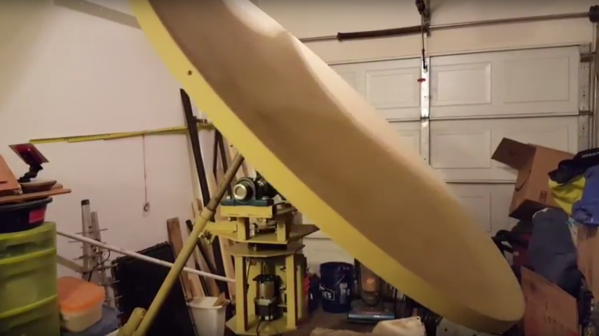There’s a magnificent constellation of spacecraft in orbit around Earth right now, many sending useful data back down to the surface in the clear, ready to be exploited. Trouble is, it often takes specialized equipment that can be a real budget buster. But with a well-stocked scrap bin, a few strategic eBay purchases, and a little elbow grease, a powered azimuth-elevation satellite dish mount can become affordable.
The satellites of interest for [devnulling]’s efforts are NOAA’s Polar-orbiting Operational Environmental Satellites (POES), a system of low-Earth orbit weather birds. [devnulling] is particularly interested in direct reception of high-definition images from the satellites’ L-band downlink. The mount he came up with to track satellites during lengthy downloads is a tour de force of junkyard build skills.
The azimuth axis rotates on a rear wheel bearing from a Chevy, the elevation axis uses cheap pillow blocks, and the frame is welded from scrap angle iron and tubing. A NEMA-23 stepper with 15:1 gearhead rotates the azimuth while a 36″ linear actuator takes care of elevation. The mount has yet to be tested in the wind; we worry that sail area presented by the dish might cause problems. Here’s hoping the mount is as stout as it seems, and we’ll look forward to a follow-up.
It would work for us, but a 4-foot dish slewing around in the back yard might not be everyone’s taste in lawn appurtenances. If that’s you and you still want to get your weather data right from the source, try using an SDR dongle and chunk of wire.
Continue reading “Junkyard Dish Mount Tracks Weather Satellites”



 For “Tears”, his sculpture of the enzyme lysozyme shown in the banner image, [Mike] started with crystallographic data that pinpoints every peptide residue in the protein. A model is created for the 3D printer, with careful attention paid to how the finished print can be split apart to allow casting. Clear PLA filament is used for the positive because it burns out of the mold better than colored plastic. The prints are solvent smoothed, sprues and air vents added, and the positive is coated with a plaster mix appropriate for the sculpture medium before the plastic is melted out and the mold is ready for casting.
For “Tears”, his sculpture of the enzyme lysozyme shown in the banner image, [Mike] started with crystallographic data that pinpoints every peptide residue in the protein. A model is created for the 3D printer, with careful attention paid to how the finished print can be split apart to allow casting. Clear PLA filament is used for the positive because it burns out of the mold better than colored plastic. The prints are solvent smoothed, sprues and air vents added, and the positive is coated with a plaster mix appropriate for the sculpture medium before the plastic is melted out and the mold is ready for casting.














